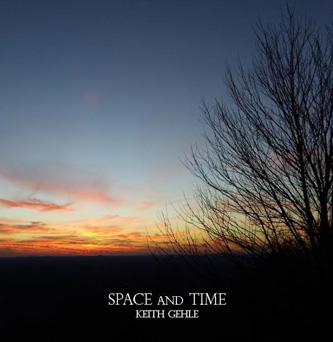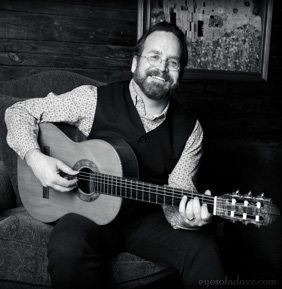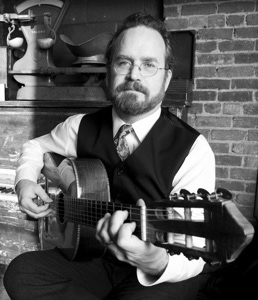 One
of the rising artists in 21st century contemporary instrumental music,
Georgia-based Keith Gehle released his CD, Space and
Time in 2016. Although he’s best known as a classical
guitarist, on Space and Time, Keith flexes his musical muscle
as a composer first and foremost, keeping the music as the central
focus. The artist's fifth solo album, Space and Time is dedicated
to his late brother Ken. The sound is superbly captured for CD by
album mastering engineer Tom Eaton. Keith plays a range of
nylon and steel string guitars and proof of his one man band sound
means that there's plenty of other sonic colors from assorted instruments
such as cello, piano, synths and more. Describing his approach to
the arranging and recording of his music on Space and Time, Keith
tells mwe3.com, “With regard to how the pieces on Space and
Time were written, they were initially conceived as solos but
with some time and reflection I found a desire to add some other instrument
sounds. The musical lines accompanying the guitar are mostly simple
things like piano octaves, drawn out keyboard strings or pads, and
synthesized virtual instruments like oboe, cello, and flute. I would
say that in many cases the music just sort of cried out for another
melody to be heard on an instrument besides the guitar.” To appreciate
Keith Gehle as a guitarist and multi-instrumentalist you are first
captured by his unique compositions, which are neoclassical in scope
yet created with a modern day soundtrack and ambient music appeal.
Fans of Tom Eaton’s recent albums and the Windham Hill sound
in general will find much to applaud about Keith Gehle’s Space
and Time. www.keithgehle.com
/ www.facebook.com
One
of the rising artists in 21st century contemporary instrumental music,
Georgia-based Keith Gehle released his CD, Space and
Time in 2016. Although he’s best known as a classical
guitarist, on Space and Time, Keith flexes his musical muscle
as a composer first and foremost, keeping the music as the central
focus. The artist's fifth solo album, Space and Time is dedicated
to his late brother Ken. The sound is superbly captured for CD by
album mastering engineer Tom Eaton. Keith plays a range of
nylon and steel string guitars and proof of his one man band sound
means that there's plenty of other sonic colors from assorted instruments
such as cello, piano, synths and more. Describing his approach to
the arranging and recording of his music on Space and Time, Keith
tells mwe3.com, “With regard to how the pieces on Space and
Time were written, they were initially conceived as solos but
with some time and reflection I found a desire to add some other instrument
sounds. The musical lines accompanying the guitar are mostly simple
things like piano octaves, drawn out keyboard strings or pads, and
synthesized virtual instruments like oboe, cello, and flute. I would
say that in many cases the music just sort of cried out for another
melody to be heard on an instrument besides the guitar.” To appreciate
Keith Gehle as a guitarist and multi-instrumentalist you are first
captured by his unique compositions, which are neoclassical in scope
yet created with a modern day soundtrack and ambient music appeal.
Fans of Tom Eaton’s recent albums and the Windham Hill sound
in general will find much to applaud about Keith Gehle’s Space
and Time. www.keithgehle.com
/ www.facebook.com
mwe3.com presents an interview with
KEITH GEHLE
 mwe3:
Can you tell us where you’re from originally and where you live
now and what you like best about it?
mwe3:
Can you tell us where you’re from originally and where you live
now and what you like best about it?
Keith Gehle: I grew up in Augusta, Georgia from the age of
five although my parents are originally from the northeast. I lived
in Athens while I was a student at the University of Georgia studying
classical guitar performance then returned to Augusta after graduation
in 1990 to work as a freelance musician and teacher. In 1997, I moved
to Atlanta where I currently reside and work performing and teaching.
I like living in Atlanta because of the many opportunities to make
a living playing live music but sometimes miss the thriving art and
music scenes you find in places like Athens and Augusta.
mwe3: How would you compare your 2016 album Space and Time
with your other albums and how has your sound and vision evolved
over the years, both as a guitarist and as a composer? Would you say
that Space and Time is your definitive musical statement to
date?
Keith Gehle: I definitely believe that Space and Time
is my best work and certainly different from my earlier albums. My
previous albums were solo guitar recordings and in most cases featured
music by other composers. However, my 2001 release, Winter Song
contained all original compositions similar to the music on Space
and Time. With all of my recording projects I try to have a musical
theme for the album. Original works, Romantic Period music, and Christmas
classics are examples of themes I’ve presented in my recordings.
Sadly, the theme for Space and Time was a response to the tragedy
of my brother Ken’s untimely death in January of 2010. And although
I tried to make an album with elements of hope, there is still, at
times, an underlying sadness in the music. Each piece on the recording
has a story behind it that relates in some way to his life and passions
or our lives together as brothers.
With regard to how the pieces on Space and Time were written,
they were initially conceived as solos but with some time and reflection
I found a desire to add some other instrument sounds. The musical
lines accompanying the guitar are mostly simple things like piano
octaves, drawn out keyboard strings or pads, and synthesized virtual
instruments like oboe, cello, and flute. I would say that in many
cases the music just sort of cried out for another melody to be heard
on an instrument besides the guitar. For example, the opening track
on the album, “Waiting For The Sun”, has a cello line that
begins around the middle of the piece. That point in the music signifies
to me the appearance of the sun at dawn as the sound shifts to the
relative major key after a fairly long stretch in minor. Once I found
that melody to accompany the guitar, I knew the recording was complete.
There were moments like that with almost all of the pieces during
the process of arranging and recording the album.
 mwe3:
Did you create Space and Time as a soundtrack to an imaginary
movie and how does the music on the CD make the most of your compositional
style? Also, what do you think about the soundtrack aspect as your
music is so cinemagraphic?
mwe3:
Did you create Space and Time as a soundtrack to an imaginary
movie and how does the music on the CD make the most of your compositional
style? Also, what do you think about the soundtrack aspect as your
music is so cinemagraphic?
Keith Gehle: I’ve always loved film music and enjoy arranging
pieces from my favorite movies for solo guitar. In 2012 I had the
privilege of producing the score for a short film by David Field entitled
Caterpillar.
It’s a beautiful work that won a number of awards at film festivals
that year. The music serves a significant role as the film has no
dialogue, just scenes with two female actors representing the same
woman in youth and old age. It was a lot of fun working with David
and composing the music and something I hope to do again someday.
I must add that I really appreciate your description of the album
as cinemagraphic as I’m always deliberately attaching images
to my music and have a deep appreciation for photography and camera
work in film. My late brother Ken was a professional photographer
and there are a number of pieces on the CD that were inspired by his
beautiful landscape photos. Probably the best example is again, track
one “Waiting for the Sun.” Ken took a photo of the sun rising
on the side of a mountain in Death Valley, California many years ago
and that became the inspiration for the music. As the piece came together
I imagined him and his wife Tamara waiting in the cold, dark desert
with an abundance of stars in the sky—perhaps sipping coffee
and talking about the simple things of life. It was in moments like
that that he seemed most at peace and something I tried to convey
in sound.
Another example of a song being inspired by a photo, in this case
a photo of mine, the album cover, is the title track “Tone Poem
No. 6 (Space and Time)”. I took the picture from a mountain
top in the brief moments while the sun set over the horizon on Thanksgiving
Day in 2013. It was one of the most amazing sunsets I’ve ever
seen. The color and contrast were simply breathtaking. I’m certain
the high vantage point helped to enhance the experience, but on another
level it felt like a gift from my brother. In many ways that was the
defining moment for the concept of the recording. The tragedy in January
of 2010 and many events before and after have helped me to understand
“time” mostly as a series of sequenced moments within “space”.
Each moment is unique, but there are some that stand out as sacred
and seem to transcend the boundaries of earthly time.
 mwe3:
Tell us about what guitars you played and recorded on Space and
Time and did you use some special microphone techniques to enhance
the guitar sound in the recording process? What was your studio setup
like for the making of the CD and what are your favorite keyboards
and which keyboards did you use on the new CD?
mwe3:
Tell us about what guitars you played and recorded on Space and
Time and did you use some special microphone techniques to enhance
the guitar sound in the recording process? What was your studio setup
like for the making of the CD and what are your favorite keyboards
and which keyboards did you use on the new CD?
Keith Gehle: The two guitars I used to record the album, one
steel string and the other nylon, were both built by Kent Everett.
The nylon string/classical guitar is my main instrument, the one I
typically play for concerts and events. I don’t usually play
steel string live, but I really appreciate the sound of steel and
found it to be the right choice for certain pieces on the record.
As far as my approach to microphones, I usually fall back to the safe
approach for recording guitars, the technique known as XY stereo.
I use a matched pair of small diaphragm Schoeps condenser microphones,
an Avalon solid state pre-amp, and an RME interface.
My goal is to attempt to capture the pure, uncolored sound of my guitar.
On one of the tracks, “Lavender Sky”, I experimented with
a miking technique called mid side stereo, but only for that track.
My keyboard set up is pretty much a simple Yamaha with built in sounds,
functioning in most cases as a controller for the MIDI software I
used. For the cello and oboe sounds, I used the Vienna Instruments
software which I really love. I must confess to being quite the novice
on the keyboard, but by layering the sounds on various tracks, I think
I was able to come up with some interesting textures in the end.
mwe3: What did engineer Tom Eaton bring to the sound during
the mastering stage? Have you heard Tom’s music and I was thinking
how much Windham Hill fans would like your Space and Time album.
Were you also influenced by the ‘Windham Hill’ sound and
who are some of your other favorite artists, then and now?
Keith Gehle: I’ve been following Tom Eaton’s work
since around the middle of 2016 when I reached out to William Ackerman
at Imaginary Road Studios about preparing the master for Space
and Time. To my ear Tom is an amazing composer/arranger, producer,
and recording engineer. And I imagine the only thing better than having
Tom master my CD would be to have him engineer and produce it. He’s
doing some terrific work with Ackerman at Imaginary Road Studios in
Vermont and in his own studio north of Boston. I was very pleased
to have one my tracks featured last October on a Journeyscapes Radio
playlist entitled “Autumn Musings”. My piece “The Escaping
Light” opened the playlist while Tom’s exceptional track
“The Raven”, from his latest album closed it. As for what
he brought to my recording, he definitely improved it both in overall
tone and flow of the tracks. He knew instinctively where to place
extra time between tracks and gave me great advice on the mixing and
final song selection.
 Regarding
Windham Hill’s recordings I would have to say that the label’s
influence on my musical journey has been substantial. My daughter
was born with A Winter’s Solstice II playing in the hospital
room. No kidding! My first purchase of a Windham Hill recording (in
the mid 80’s) was ironically the first “A Winter’s
Solstice” album. With that album I was at first struck by the
beautiful image on the front cover and the simple white background
and light gray text on the back. I was intrigued by the wintry cover
image but moved even more by the incredible music. And it was with
that recording that I heard my first William Ackerman composition,
a piece entitled “New England Morning”. I was hooked and
have been a fan of his ever since.
Regarding
Windham Hill’s recordings I would have to say that the label’s
influence on my musical journey has been substantial. My daughter
was born with A Winter’s Solstice II playing in the hospital
room. No kidding! My first purchase of a Windham Hill recording (in
the mid 80’s) was ironically the first “A Winter’s
Solstice” album. With that album I was at first struck by the
beautiful image on the front cover and the simple white background
and light gray text on the back. I was intrigued by the wintry cover
image but moved even more by the incredible music. And it was with
that recording that I heard my first William Ackerman composition,
a piece entitled “New England Morning”. I was hooked and
have been a fan of his ever since.
I appreciate all of the music from the Windham Hill Artists but particularly
Ackerman, George Winston, Shadowfax and everyone on the Guitar
Sampler CD. That was a big record for me. Danny Heines’ recording
of “Sun And Water” from that album is so amazing! In full
disclosure I should confess that I have many other influences in various
genres of music including the Beatles, REM, Andrew York, Christopher
Parkening and John Sutherland, my teacher at The University of Georgia.
mwe3: With Space and Time recently released, what plans
do you have for your music this coming year in 2017 and how about
other plans that you’re developing as far as music writing, performances,
gigs and recording?
Keith Gehle: I’m definitely excited for 2017. With 40
plus original works composed and ready to be recorded, I hope to release
at least one new album by the end of the year, maybe two… Another
exciting bit of news is  that
three of my compositions will be published by Mel Bay in March as
part of a book entitled Music Of The Americas. Two of the three
compositions in the book are from the Space and Time CD (“Cooper’s
Creek” and “Waiting For The Sun”) which will be another
avenue for people to discover the recording. I’ll stay busy as
always playing music for events as well as some teaching and I may
dive back into the concert scene in an effort to further promote my
recordings. We’ll see how the future unfolds. Above all else,
I hope my music gives the world a measure of light and hope.
that
three of my compositions will be published by Mel Bay in March as
part of a book entitled Music Of The Americas. Two of the three
compositions in the book are from the Space and Time CD (“Cooper’s
Creek” and “Waiting For The Sun”) which will be another
avenue for people to discover the recording. I’ll stay busy as
always playing music for events as well as some teaching and I may
dive back into the concert scene in an effort to further promote my
recordings. We’ll see how the future unfolds. Above all else,
I hope my music gives the world a measure of light and hope.



